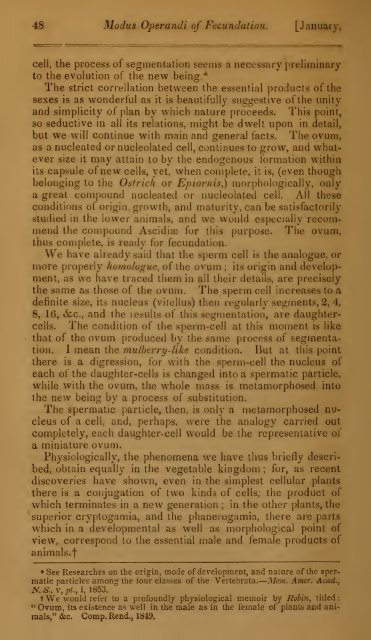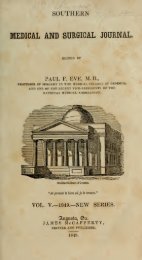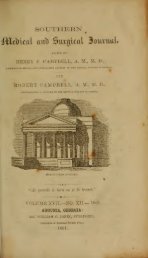Southern Medical and Surgical Journal - Georgia Regents University
Southern Medical and Surgical Journal - Georgia Regents University
Southern Medical and Surgical Journal - Georgia Regents University
Create successful ePaper yourself
Turn your PDF publications into a flip-book with our unique Google optimized e-Paper software.
f—48 Modus Oper<strong>and</strong>i of Fecundation. [January,cell, the process of segmentation seems a necessary preliminaryto the evolution of the new being. 1The strict correllation between the essential products of thesexes is as wonderful as it is beautifully suggestive of the unity<strong>and</strong> simplicity of plan by which nature proceeds. This point,so seductive in all its relations, might be dwelt upon in detail,but we will continue with main <strong>and</strong> general facts. The ovum,as a nucleated or nucleolated cell, continues to grow, <strong>and</strong> whateversize it may attain to by the endogenous formation withinits capsule of new cells, yet, when complete, it is, (even thoughbelonging to the Ostrich or Epiomis,) morphologically, onlya great compound nucleated or nucleolated cell. All theseconditions of origin, growth, <strong>and</strong> maturity, can be satisfactorilystudied in the lower animals, <strong>and</strong> we would especially recommendthe compound Ascidiaj lor this purpose. The ovum,thus complete, is ready lor fecundation.We have already said that the sperm cell is the analogue, ormore properly homologue, of the ovum ; its origin <strong>and</strong> development,as we have traced them in all their details, are preciselythe same as those of the ovum. The sperm cell increases to adefinite size, its nucleus (vi tell us) then regularly segments, 2, 4,8, id, &c, <strong>and</strong> the results of this segmentation, are daughtercells.The condition of the sperm-cell at this moment is likethat of the ovum produced by the same process of segmentation.I mean the mulberry-like condition. But at this pointthere is a digression, for with the sperm-cell the nucleus ofeach of the daughter-cells is changed into a spermatic particle,while with the ovum, the whole mass is metamorphosed intothe new being by a process of substitution.The spermatic particle, then, is only a metamorphosed nucleusof a cell, <strong>and</strong>, perhaps, were the analogy carried outcompletely, each daughter-cell would be the representative ofa miniature ovum.Physiologically, the phenomena we have thus briefly described,obtain equally in the vegetable kingdom; for, as recentdiscoveries have shown, even in the simplest cellular plantsthere is a conjugation of two kinds of cells, the product ofwhich terminates in a new generation ; in the other plants, thesuperior cryptogamia, <strong>and</strong> the phanerogamia, there are partswhich in a developmental as well as morphological point ofview, correspond to the essential male <strong>and</strong> female products ofanimals.* See Researches on the origin, mode of development, <strong>and</strong> nature of the spermaticparticles among the four classes of the Vertebrata. Mem. Amcr. Acad.,N. S., v, pt., i, 1853.t We would refer to a profoundly physiological memoir by Robin, titled:"Ovum, its existence as well in the male as in the female of plants <strong>and</strong> animals,"&c. Comp. Rend., 1849.








